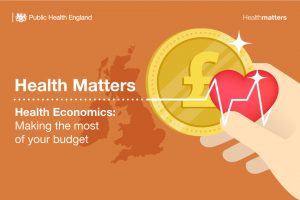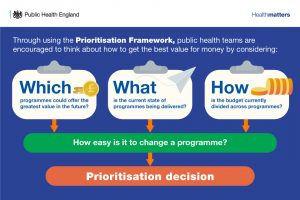
We hope our latest edition of Health Matters – on the subject of ‘Health Economics and making the most of your budget’ – will help you and other professionals by compiling key facts, figures and evidence of effective interventions.
In this blog we’ve published the answers to a number of questions we received from professionals across the UK at the recent launch teleconference.
Cost saving and public health
Is cost saving a key priority for public health, and are we setting the bar too high for public health interventions?
Although some interventions do produce cashable savings in the short term, this is a very high bar to set and savings will often be felt over a long time period.
The aim of prevention, however, should not just be to save money, in the same way that it is not the sole aim of treatment. In our tools, we do try to separate outcomes into financial savings, whether it is to local authorities or to the NHS, as well as the wider benefits such as those relating to the value placed on health, productivity gains and the broader economy.
The new Secretary of State has said that he has three priorities: the workforce, technology and prevention. ‘Prevention’ is not just in a traditional sense of how we reduce demand for healthcare services, but how we help people stay well for longer, stay in their own homes and communities for longer, and stay productive in the workplace for longer. It’s very much a broader public health understanding of what we mean by ‘prevention’.
Measuring the benefit of wellbeing using Health Economics tools
Can PHE’s Health Economics tools be used to measure the benefit of wellbeing, as well as some of the more quantifiable and less subjective benefits around prevention?
The most recent refresh of the Treasury’s Green Book – the government’s guide to how economic appraisal and evaluation should be conducted – places a much greater emphasis on wellbeing and we are seeing it rise up the agenda.
To some extent we are limited in terms of what the evidence of particular interventions shows, and most of PHE’s tools currently concentrate on the more traditionally measured aspects of health. However, there is an increasing understanding and dialogue around incorporating wellbeing more broadly into economic evaluations. Therefore, this is not something that we can currently focus on achieving, but in the future we aim to play a much greater part in how we measure the wellbeing benefits of public health interventions.
Use of the Prioritisation Framework by local authorities

Has PHE’s Prioritisation Framework been piloted or successfully used by local government?
During the initial part of developing the Prioritisation Framework, we ran a number of pilot sites across the country and they used the tool and fed back to us. This was very helpful as it provided guidance on how to improve and streamline the tool, and we have now translated these findings into the supporting materials that are available alongside the tool.
There is also an evaluation taking place, which is being run by the National Institute for Health Research’s School for Public Health Research. They are reviewing and summarising the findings, some of which will be presented at the PHE annual conference in September. It will then be written up and shared, so by the end of the year there will be a comprehensive log of lessons learned.
In addition to this, this edition of Health Matters includes case studies from Shropshire and Durham – two of the pilot sites – which can be viewed as examples in the meantime. You can also view a recorded webinar on the Prioritisation Framework on the Health Economics main landing page on GOV.UK, which includes some reflections on the work done with the framework in Durham, Shropshire and East Riding of Yorkshire.
Incorporating user feedback into Health Economics tools
Is user feedback being incorporated into PHE’s Health Economics tools to make sure they are as relevant and accessible as possible? If so, how is this being done?
Receiving and incorporating feedback is essential to the usability of Health Economics tools, and therefore all of PHE’s tools are equipped with a survey for users to complete. This feedback is helping us understand how to develop better resources in the future.
In terms of the development of Health Economics tools, there is always a steering group of experts and interested stakeholders, often including representatives from the third sector and clinical experts, to help shape the project. There is also a user group, typically made up of people from local authorities, who test the product when it is nearly complete and provide feedback. For a couple of our recent projects, user workshops were held at the start to ensure that user needs were integrated to the development of our tools. This will typically be our way of working going forward. Again, doing these things makes sure that PHE’s Health Economics products are as impactful as possible.
Shifting the case for prevention earlier in the life cycle
Should the case for prevention shift to earlier in the life cycle, and how can the body of evidence be used in prevention?
We’re interested in prevention across the life course, but particularly early years as the impact across the life course can be very significant. The Best Start in Life tool, one of our ROI tools, looks at interventions aimed at children aged zero to five years old and pregnant women. So, we have started working in this area and will continue to do so, and build up the economic case for prevention at a very early stage in the life course.
This is going to be consistent with one of the themes in the NHS ten-year plan, which is a focus on children and young people.
Health Matters
Read the full edition of Health Matters on 'Health Economics and making the most of your budget’ here.
Health Matters is a resource for professionals, which brings together the latest data and evidence, makes the case for effective public health interventions, and highlights tools and resources that can facilitate local or national action. Visit the Health Matters area of GOV.UK or sign up to receive the latest updates through our e-bulletin. If you found this blog helpful, please view other Health Matters blogs.

1 comment
Comment by ann Louise kinmonth posted on
why do you not begin with the pregnant mother and foetus rather than wait until birth?